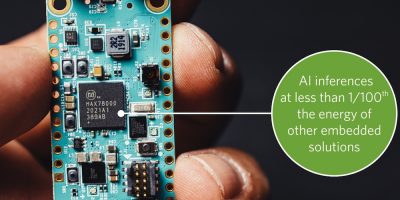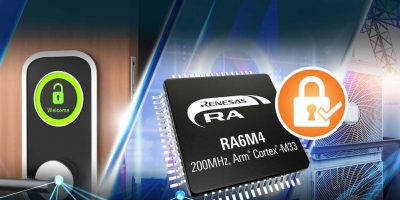To reduce energy consumption and latency by a factor of over 100 to enable complex embedded inference decisions at the IoT edge, Maxim Integrated has developed the MAX78000 low power neural network accelerated microcontroller.
It moves AI to the edge without performance compromises in battery-powered internet of things (IoT) devices, says the company. It is able to execute AI inferences at less than 1/100th the energy of software solutions to dramatically improve the run-time for battery-powered AI applications. It also enables new, complex AI use cases.
The MAX78000 executes inferences 100x faster than software running on low power microcontrollers and at a fraction of the cost of FPGAs or GPUs, continues Maxim.
Rather than gathering data from sensors, cameras and microphones, sending that data to the cloud to execute an inference, then sending an answer back to the edge, which is challenging due to poor latency and energy performance. Using low power microcontrollers can be used to implement simple neural networks but latency suffers and only simple tasks can be run at the edge. By integrating a dedicated neural network accelerator with a pair of microcontroller cores, the MAX78000 overcomes these limitations, enabling machines to see and hear complex patterns with local, low-power AI processing that executes in real-time.
Applications such as machine vision, audio and facial recognition can be made more efficient as the MAX78000 can execute inferences at less than 1/100th the energy required by a microcontroller. The MAX78000’s specialised hardware is designed to minimise the energy consumption and latency of convolutional neural networks (CNNs). Hardware runs with minimal intervention from any microcontroller core, making operation extremely streamlined. Energy and time are only used for the mathematical operations that implement a CNN. To get data from the external world into the CNN engine efficiently, customers can use one of the two integrated microcontroller cores: the low power Arm Cortex-M4 core, or the even lower power RISC-V core.
The MAX78000EVKIT# includes audio and camera inputs, and out-of-the-box running demos for large vocabulary keyword spotting and facial recognition. Complete documentation helps engineers train networks for the MAX78000 in the tools they are used to using, either TensorFlow or PyTorch.
The MAX78000 is available from authorised distributors. The MAX78000EVKIT# evaluation kit is also available now.







